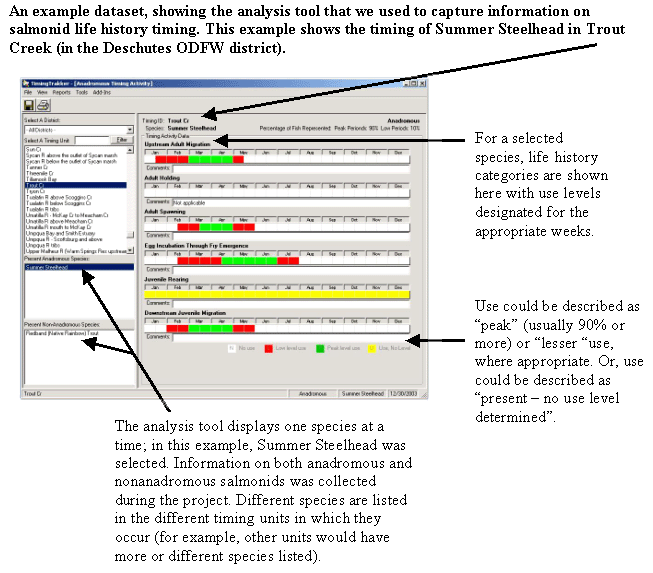
![]()
January 2004 Feature
|
January 2004 Feature |
|
|
Having the timing of their life - Salmon in Oregon streams
--by Audrey Hatch The timing of when salmon choose to migrate upstream, spawn, incubate eggs, and rear juveniles is crucial to their continued survival and reproductive success. For example, as salmon move between fresh and saltwater habitat, they encounter very different conditions and environmental pressures. Therefore, it is important that their migration occur at the appropriate time in their development and under the appropriate environmental conditions. In some cases, life history timing can even be a key factor in determining population structure, with early- and late- migrating groups of individuals becoming reproductively isolated. Because every fish population faces unique environmental conditions, biologists often focus on the population level to get an accurate understanding of life history timing. Understanding the population's timing is essential to sound, science-based environmental management. Many aspects of environmental management can be better informed with an understanding of life stage timing. For example, in-stream work such as harvesting, dredging, and creating water diversions could be scheduled so as not to impact sensitive fish at an important time in the life cycle. Activities that could affect the water's temperature can also be planned. In fact, temperature is important to life history timing in several ways. At any given field site, temperature has a direct and immediate effect on fish timing. Warmer temperatures typically increase the speed of embryonic development and fry movement. On a larger scale, global changes in temperature, rainfall, or oceanic conditions could affect salmonid populations by altering migration timing. To evaluate the consequences of different management options under changing environmental conditions, it is essential to understand the timing of the fish populations that might be affected. However, fish timing for any given species can vary widely from stream to stream. Therefore, it is important for decision-makers to understand the unique attributes of populations in different locations. To address this need for information about salmonid life stage timing, the Oregon Department of Fish and Wildlife (ODFW)'s Natural Resource Information Management Program (NRIMP) has developed a database of salmonid life history timing information. NRIMP collected information from biologists on the timing of fish use throughout the state as part of the 24K fish Fish Habitat D d istribution Development P p roject ( for more information on this project see http://rainbow.dfw.state.or.us/nrimp/24k/index.htm ). Stream systems were divided into “timing units” based on geographical attributes and natural reach breaks. Biologists then determined the timing of fish use, in 2-week in tervals crements , for various life history activities (for example, migration, spawning, egg incubation, juvenile rearing) . Where possible, data contributors provided documentation or survey data that supported this information, but in many cases professional opinion was invaluable as data contributors accounted for year-to-year variation and provided their best estimates of fish use. The development of the timing database has been supported by ODFW, Oregon Department of Environmental Quality (ODEQ), the Oregon Watershed Enhancement Board (OWEB), and the U.S. Environmental Protection Agency, and the database has been useful to several resource agencies. For example, in 2003, ODEQ prepared a response to a federal court decision on their temperature standard, requiring detailed knowledge of “where and when” salmonids use Oregon streams for migration, breeding and other key life history activities (for more information on the development of this policy see http://www.deq.state.or.us/wq/standards/wqstdstemp.htm ). The NRIMP timing database provided the essential detailed information. To supplement the timing database, NRIMP has collected information on salmonid life history timing in the published scientific literature and in agency reports. Most recently, NRIMP has collected timing information for some of Oregon's non-anadromous basins, focusing on resident trout and other species of interest. The timing data can be accessed via: http://rainbow.dfw.state.or.us/nrimp/information/timing/index.htm This database is useful for recreational planning and as a technical resource. If you have any information that you think could contribute to this dataset, please send this information to: Cedric.Cooney@oregonstate.edu  Some suggestions for further reading: Finney, B.B., I. Gregory-Eaves, M.S.V. Douglas, and J.P. Smoll. 2002. Fisheries productivity in the northeastern Pacific Ocean over the past 2,200 years. Nature 416: 729-733. Friedland, K.D., D. G. Reddin, J.R. McMenemy, and K.F. Drinkwater. 2003. Multidecadal trends in North American Atlantic salmon ( Salmo salar ) stocks and climate trends relevant to juvenile survival. Canadian Journal of Fisheries and Aquatic Sciences 60: 563-383. Hodgson, S. and T. P. Quinn. 2002. The timing of adult sockeye salmon migration into fresh water: adaptations by populations to prevailing thermal regimes. Canadian Journal of Zoology 80: 542-555. Holtby, L.B., T.E. McMahon, and J.C. Scrivener. 1989. Stream temperatures and inter-annual variability in the emigration timing of coho salmon ( Onchorhynchus kisutch ) smolts and fry and chum salmon ( O. keta ) fry from Carnation Creek, British Columbia. Canadian Journal of Fisheries and Aquatic Sciences 46: 1396-1405. Obards, M.D. and T. P. Quinn. 2002. The migratory timing of adult summer-run steelhead in the Columbia R over six decades of environmental change. North American Journal of Aquaculture 131: 523-536. Quinn, T.P., M.J. Unwin, M.T. Kinnison. 2000. Evolution of temporal isolation in the wild: genetic divergence in timing of migration and breeding by introduced Chinook salmon populations . Evolution 54: 1372-85. Roper, B.B. and D.L. Scarnecchia. 1999. Emigration of age-0 Chinook salmon ( Oncorhynchus tshawytscha ) smolts from the upper South Umpqua River basin, Oregon USA. Canadian Journal of Fisheries and Aquatic Sciences 56: 939-946.
|
|
|